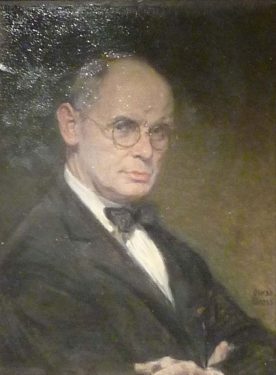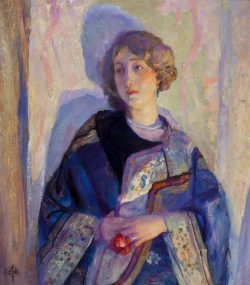Oscar Gross, Portrait of Otto Hake, 1929, oil on canvas (29 by 17 inches), collection of the Palette and Chisel Chisel Academy of Fine Arts, Chicago.

Otto Hake 1876–1965
A native of Ulm, Germany, Otto Eugene Hake immigrated to the U.S. as a teen and apprenticed with a wood-engraver in St. Louis. He arrived in Chicago in 1892 to work as an engraver and illustrator for the Binner-Wells Company. Hake enlisted during the Spanish-American War of 1898 and earned American citizenship when he turned twenty-one. He began his formal art training at the Art Institute of Chicago in 1905, the year he received his first mural commission, for a Chicago public school. He also began studying and soon teaching as well at the Chicago Academy of Fine Arts (founded in 1902). Around the same time, he launched a career as a freelance illustrator and designer. Hake went abroad in 1912 to study at the Académie Colarossi in Paris and at the Debschitz Academy in Munich.
Much of Hake’s professional life revolved around the Palette and Chisel Club, an organization of Chicago artists supporting themselves with commercial work while pursuing fine-art aspirations. Hake joined the club in 1905 and served as its president in 1910 and again in 1926–1927. He also edited its journal, The Cow Bell, and began teaching classes at the club in the 1920s. Hake was among the club members who together painted the group portrait known as At Oldenburg in 1910, and he is one of several artists who decorated the walls of a room in the club headquarters in 1940.
Hake exhibited at various local venues, beginning with paintings and sketches in the Palette and Chisel Club’s show at the Art Institute in 1916. He also occasionally participated in the Art Institute’s “Chicago and Vicinity” annuals during the 1920s and early 1930s. In those years, the high point in Hake’s career, he won a number of honors in the Palette and Chisel’s annual exhibitions. In 1927, he held his own show of sketches and drawings at the club, which won praise from the Chicago Tribune’s critic Eleanor Jewett.i In addition to figural works, Hake painted landscapes, finding subjects in the Great Smoky Mountains of North Carolina (which he visited in 1926 with Rudolph Ingerle); Brown County, Indiana; and throughout the Chicago region. He also made color woodblock prints of landscape subjects, perhaps as early as the mid-1910s. In the 1930s, however, Hake was best known as a painter of murals, several of which he executed as part of the federal government’s New Deal relief projects sometimes known collectively as the WPA. His murals decorated schools and other public buildings in and around Chicago, notably the Museum of Science and Industry and the Lakeshore Athletic Club building (now owned by Northwestern University). After he completed two school mural projects in 1940, Hake effectively retired from Chicago’s art scene.
Wendy Greenhouse, PhD
i Eleanor Jewett, “Otto Hake to Open Exhibition Today at Palette and Chisel,” Chicago Tribune, Apr. 12, 1927; Eleanor Jewett, “Art and Artists. Critic Visits Some Current Exhibits,” Chicago Tribune, Apr. 17, 1927.
